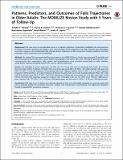| dc.contributor.author | Tchalla, Achille E. | en_US |
| dc.contributor.author | Dufour, Alyssa B. | en_US |
| dc.contributor.author | Travison, Thomas G. | en_US |
| dc.contributor.author | Habtemariam, Daniel | en_US |
| dc.contributor.author | Iloputaife, Ikechukwu | en_US |
| dc.contributor.author | Manor, Brad | en_US |
| dc.contributor.author | Lipsitz, Lewis A. | en_US |
| dc.date.accessioned | 2014-10-01T14:29:36Z | |
| dc.date.issued | 2014 | en_US |
| dc.identifier.citation | Tchalla, Achille E., Alyssa B. Dufour, Thomas G. Travison, Daniel Habtemariam, Ikechukwu Iloputaife, Brad Manor, and Lewis A. Lipsitz. 2014. “Patterns, Predictors, and Outcomes of Falls Trajectories in Older Adults: The MOBILIZE Boston Study with 5 Years of Follow-Up.” PLoS ONE 9 (9): e106363. doi:10.1371/journal.pone.0106363. http://dx.doi.org/10.1371/journal.pone.0106363. | en |
| dc.identifier.issn | 1932-6203 | en |
| dc.identifier.uri | http://nrs.harvard.edu/urn-3:HUL.InstRepos:12987416 | |
| dc.description.abstract | Background: Falls may occur as unpredictable events or in patterns indicative of potentially modifiable risks and predictive of adverse outcomes. Knowing the patterns, risks, and outcomes of falls trajectories may help clinicians plan appropriate preventive measures. We hypothesized that clinically distinct trajectories of falls progression, baseline predictors and their coincident clinical outcomes could be identified. Methods: We studied 765 community-dwelling participants in the MOBILIZE Boston Study, who were aged 70 and older and followed prospectively for falls over 5 years. Baseline demographic and clinical data were collected by questionnaire and a comprehensive clinic examination. Falls, injuries, and hospitalizations were recorded prospectively on daily calendars. Group-Based Trajectory Modeling (GBTM) was used to identify trajectories. Results: We identified 4 distinct trajectories: No Falls (30.1%), Cluster Falls (46.1%), Increasing Falls (5.8%) and Chronic Recurring Falls (18.0%). Predictors of Cluster Falls were faster gait speed (OR 1.69 (95CI, 1.50–2.56)) and fall in the past year (OR 3.52 (95CI, 2.16–6.34)). Predictors of Increasing Falls were Diabetes Mellitus (OR 4.3 (95CI, 1.4–13.3)) and Cognitive Impairment (OR 2.82 (95CI, 1.34–5.82)). Predictors of Chronic Recurring Falls were multi-morbidity (OR 2.24 (95CI, 1.60–3.16)) and fall in the past year (OR 3.82 (95CI, 2.34–6.23)). Symptoms of depression were predictive of all falls trajectories. In the Chronic Recurring Falls trajectory group the incidence rate of Hospital visits was 121 (95% CI 63–169) per 1,000 person-years; Injurious falls 172 (95% CI 111–237) per 1,000 person-years and Fractures 41 (95% CI 9–78) per 1,000 person-years. Conclusions: Falls may occur in clusters over discrete intervals in time, or as chronically increasing or recurring events that have a relatively greater risk of adverse outcomes. Patients with multiple falls, multimorbidity, and depressive symptoms should be targeted for preventive measures. | en |
| dc.language.iso | en_US | en |
| dc.publisher | Public Library of Science | en |
| dc.relation.isversionof | doi:10.1371/journal.pone.0106363 | en |
| dc.relation.hasversion | http://www.ncbi.nlm.nih.gov/pmc/articles/PMC4153626/pdf/ | en |
| dash.license | LAA | en_US |
| dc.subject | Medicine and Health Sciences | en |
| dc.subject | Clinical Medicine | en |
| dc.subject | Geriatrics | en |
| dc.subject | Health Care | en |
| dc.subject | Public and Occupational Health | en |
| dc.title | Patterns, Predictors, and Outcomes of Falls Trajectories in Older Adults: The MOBILIZE Boston Study with 5 Years of Follow-Up | en |
| dc.type | Journal Article | en_US |
| dc.description.version | Version of Record | en |
| dc.relation.journal | PLoS ONE | en |
| dash.depositing.author | Tchalla, Achille E. | en_US |
| dc.date.available | 2014-10-01T14:29:36Z | |
| dc.identifier.doi | 10.1371/journal.pone.0106363 | * |
| dash.contributor.affiliated | Tchalla, Achille E. | |
| dash.contributor.affiliated | Dufour, Alyssa | |
| dash.contributor.affiliated | Lipsitz, Lewis | |
| dash.contributor.affiliated | Travison, Thomas | |


